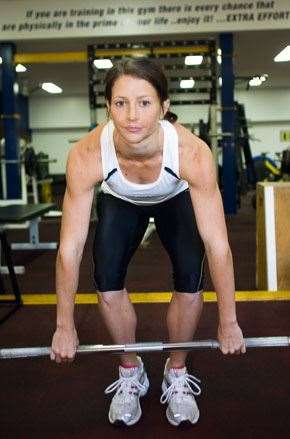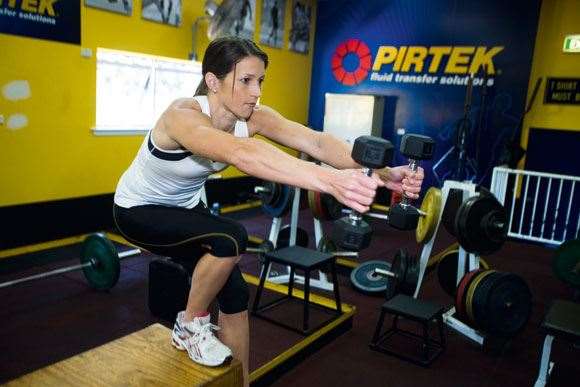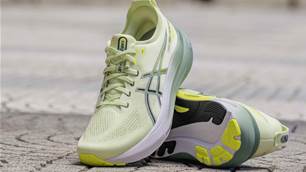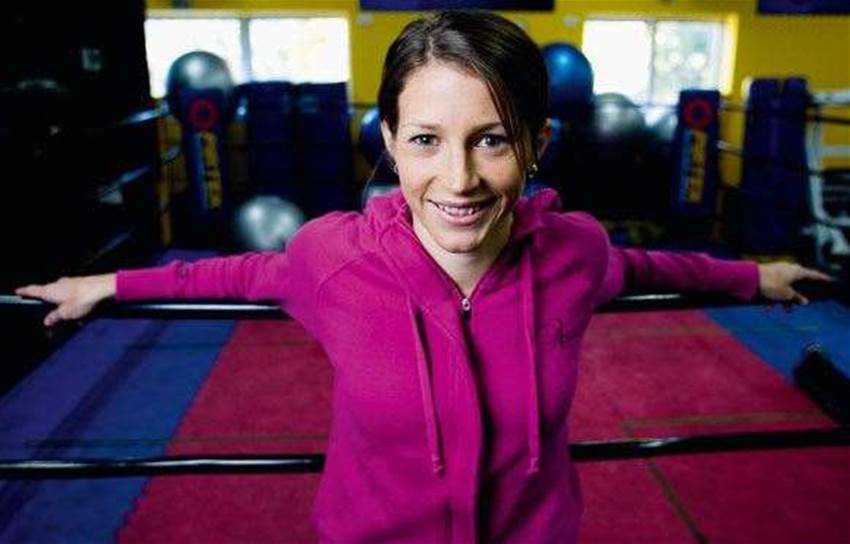Twelve months back, Hayley Butler was sitting on a couch watching Dani Samuels wheeling her way to World Championship gold in Berlin.
Twelve months back, Hayley Butler was sitting on a couch watching Dani Samuels wheeling her way to World Championship gold in Berlin.
 Hayley Butler
Hayley ButlerImages: Warren Clarke
A talented hurdler as a youngster, Butler had been off the circuit for two years. She’d married, bought a house and given birth to her first son, Cooper. But as she watched Samuels’ ecstatic celebrations, Butler realised she wanted back. Not to compete, or anything ridiculous like that. Just to have a run, turn the legs over, burn off her “mum-tum”. So she started running again. Her times were good. So she started running a little more. Her times kept dropping. She ran more. Come the Australian Nationals in March this year, she obliterated the field in the 100m hurdles, running an A-Qualifying time for the Commonwealth Games. She’s still shaking her head in disbelief: “I just kept telling people to pinch me. I couldn’t believe how fast everything was moving, how ... how awesome everything was. It was a crazy, crazy time.” On September 15 the west Sydney mum will compete in the Athletic All Stars extravaganza at Homebush. A fortnight later she’ll be heading to Delhi.
Getting started
“When I came back I didn’t think I’d compete again – I just wanted to get fit again – so I called my coach, Penny Gillies, and she took me in with open arms. My first session back was as simple as a ten-minute jog with some stretching and basic drills, just to get my leg turnover happening again. The next session, I did a 20-minute jog and some run-throughs at a steady pace, perhaps 80 per cent. And from there it was just about building it up. I was feeling really good, so we started doing some short sprint work: ten reps of 30m sprints, that sort of stuff. Again, it felt good, so we upped the distances – four sets of 100m, four sets of 150m. We started to really test out my fitness, and my times were consistent with where they’d been before my break, so I started to sprint from there.”
Mental hurdles
“When I came back I actually didn’t want to hurdle. I used to hurdle when I was younger – that was my pet event – but I was honestly scared when I came back. It had been such a long time and there were so many unknowns: I didn’t know if I’d be any good, didn’t know if I could still make it over the hurdles, didn’t know how my body was going to deal with it. Plus, I’d had a shoulder reconstruction [an Oz-tag injury], so I was very hesitant. But when my sprint times proved so good, my coach started saying, ‘Come on, let’s hurdle.’ I wasn’t keen at all, but finally I gave in. Thank God I did!”
Perspective
“I think being a mother has definitely had a positive impact on my athletics. As much as athletics means to me, as much as I put 100 per cent effort into it, I now realise there are more important things in my life. My son, my husband, my house – I’ve got that whole family life now. Things are happy at home, so now I’m at the track because I want to be, not because I have to be. And no matter how bad things are on the track – bad times, bad sessions – when I get home it just doesn’t matter.”
 Hayley Butler Weight training
Hayley Butler Weight trainingImages: Warren Clarke
Self control
“I’m very strict with my eating. My diet’s very much high protein, low carb, low sugar. And it’s also about eating at the right times. I’ll wake up and have breakfast, which is where I get my calcium – cereal with milk or yoghurt. Before morning training I’ll have fruit. Lunch, I’ll have a salad with ham or eggs or tuna. Before afternoon training I’ll have some nuts and after training I’ll have all my protein supplements. And then for dinner I’ll have meat with heaps of vegies. The important thing with dinner is portion size – I make sure my meat is always palm-sized. I also don’t drink anything but water – not even juice. I even don’t drink too much water because I like to feel light when I’m training. So, yes, I’m very strict. My one splurge is banana on toast when I’m going into competition – it’s the only time I’ll have bread.”
Core beliefs
“Everything I do in the gym is very specific to hurdling and sprinting. Every exercise – from upper body, to core, to leg work – is about using every single part of my body. I’ll never sit down and just do leg presses, for example. In a typical core session I’ll usually do three exercises, broken up into three sets of ten repetitions. Most of these exercises are centred around a prone hold position, with my feet up on the Swiss ball. A typical exercise involves doing a push-up with my feet resting on a ball then, at the top of the push-up, I pullthe ball in with my legs. That’s a typical core exercise – it hits my stomach, but it’s also working my arms, my chest, my legs. And as I get stronger at that exercise we can always make it more difficult. So, for example, I could just have one foot resting on the ball, or I could have my hands resting on a stability ball. All these little variations just make it harder to stabilise the movement.
“At the end of each session I’ll always finish with another ab exercise on the floor. Today I was doing seal rolls, where I start on my back, roll to the side, then do a V sit-up. The trick with this exercise is to make sure your arms and legs don’t touch the ground, so your core is switched on throughout the movement.“Also, every night in front of the telly, I’ll do 300 sit-ups. No one’s really told me to, but it’s just that little bit extra. You know, after having a baby I can always afford to do a little bit more!”
Full-body strength
“Again, my weights work is very specific, with each exercise hitting my entire body, not just a single group of muscles. I want to get stronger, but I don’t want to bulk up with muscle mass. Basic exercises I do are clean and jerks, dead lifts and power cleans. Another exercise is single-leg squats, where I stand on a box, hold a weight out in front of me, and drop my gluts to my heel. I also do an exercise where I rest the end of a barbell on the floor, then hold the top of the barbell [which is weighted]. From there I drop to the start position, then explode out, pushing the barbell into a vertical position as I drive up. It’s a great exercise for working that strength from the blocks. With each of these exercises I’ll normally do around four sets, with reps ranging from four to eight.“Sometimes I super-set my exercises. So if I’m doing, say, power cleans, I’ll super-set that with a med-ball exercise. For example, I’ll begin in the start position, holding a four-kilo med ball, and I explode out of that position, throwing the ball to my trainer who’ll be standing 15m away. That just adds some fast-twitch, explosive work to my gym sessions. At the moment, I’m only super-setting one exercise per session because I’m focussing on heavier pushing. As I get closer to competition I’ll be doing lighter pushing with more super-sets.”
 Hurdle Training
Hurdle TrainingImages: Warren Clarke
Rubber legs
“People say to me, ‘You’re a hurdler, you should be able to do the splits ... ’ No – that’s not the case! I’m reasonably flexible but, particularly after having a baby, my hips are really tight. As you can imagine with hurdling – that’s not good. So I do a lot of static stretching after sessions and at night. I also do a lot of dynamic stretching before a session. For example, I’ll touch my toes, then walk my hands forward so I’m forming an upside down V shape, then I’ll walk my feet forward until I’m back in a standing position. I also do a lot of lunges and side lunges, or I’ll lie on my back and lift my legs and then rotate them from side to side. After I’ve done those dynamic stretches my coach will get me to do some trail-leg drills over a row of hurdles, just to loosen my hips up. I also go to physios and chiropractors, who get stuck in there.”
Track work
“At the start of each track session I’ll normally spend ten minutes doing drills – bounding, high knees, butt kicks, skipping, etc. After that – because I’m a hurdler, lucky me – I get to do more drills. So, my coach will put out a row of four hurdles, probably a foot apart, and I’ll do lead-leg, trail-leg, and through-the-middle drills. Basically, the focus is on rapid cadence, making my movements as fast and explosive as possible. It’s all about quick feet, snapping my legs over the hurdle. It’s actually quite dangerous! After that my coach will spread the four hurdles out on the track at a distance where I need to take five steps between each hurdle (in a normal race I’d take three steps). Then I do the same drills but with stretches of running between each hurdle. After that, we’ll take that drill-work and convert it into a race scenario. I’ll normally begin by concentrating on my start and the first hurdle. So, I’ll do four starts which include jumping that first hurdle. Then I’ll gradually add more hurdles until I’ve got eight on the track and I’m doing a full run-through.”
Fit the cycle
“We normally pinpoint the meet we’re working towards [at the moment, of course, it’s Delhi] and then we’ll work back in six-week blocks. I’ve just finished a six-week block of heavy strength work in the gym and conditioning work on the track. There was a lot of hill work and a lot of 300m and 200m run-throughs. I didn’t do any technical hurdling work in that block. I’ve now started another six-week block where my focus is still strength, but I’m now concentrating on turning that strength into power. In the gym, the workload is still heavy but I’m now starting to super-set that with some explosive work. On the track I’m doing a few short, fast sprint sessions with some technical hurdling work thrown in. After this block the work starts getting a lot lighter, a lot more explosive. Then we’re into the taper period for Delhi. In the gym it’ll be very light, very fast. On the track it’ll be two or three hurdles sessions with one speed session. I won’t be running anything over 50m in this phase. Basically it’s all feel-good stuff; exercises that make me feel fast, powerful and quick. If you feel good then you’ll be confident going into the race.”
– Aaron Scott
Related Articles

I was not born to run

Karrie calls for ‘more positive messages’ in golf













